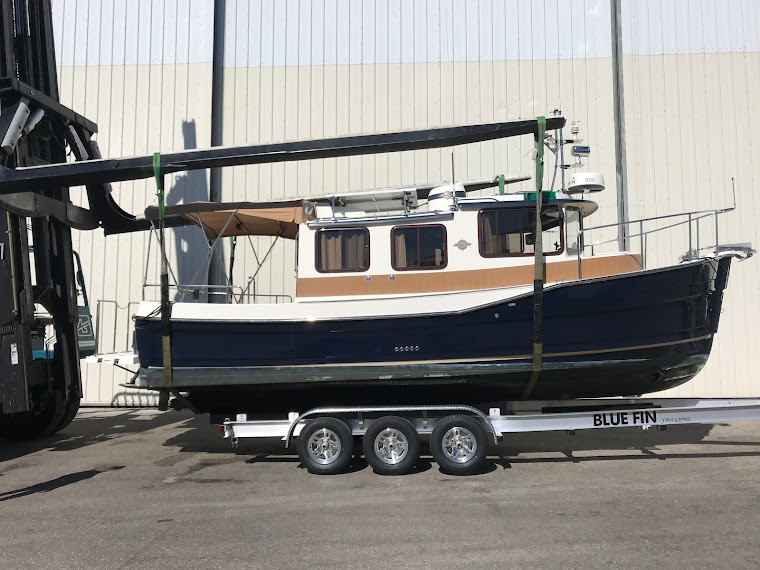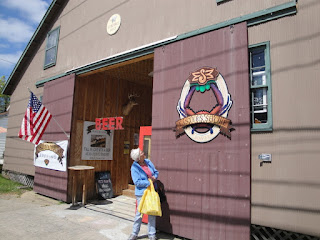Chesapeake West and East
After hearing raves about Solomons
from fellow cruisers over the past four months, we were a little underwhelmed
but did manage to enjoy a couple days on the mooring balls at Zahniser’s Yacht
Center. They provide every service – and as already posted, the best bathrooms.
We used the shuttle to buy out the Food Lion and again to haul 10 gallons of
oil to feed the diesel. The wonderful Scotty again scored high points with his
recommendation of the Rockfish Bites at Stoneys – the local take on Buffalo
wings. We felt obligated to taste them
since we have been dodging rockfish fishing boats since the season opened. The
Calvert Marine Museum was a pleasant surprise. Their chatty guide and fellow
boater, Buddy, and the attractive displays educated us on the marine life of
the Chesapeake both the native and invasive species. We also enjoyed climbing
the Drum Point lighthouse which was moved and preserved at the museum as one of
three screw type structure remaining. While they were stable and easy to
install, I guess they did not hold up well to ice storms. The two story living
accommodations on the light, however, were spacious and charmingly decorated in
the style of the early 1900s as recalled by Mary Weems who was born in the
lighthouse. This attractive spot on Back Creek also included a shipbuilding
workshop to die for. It reminded us of the volunteer program we
visited in Beaufort, NC. These volunteers also build and restore boats and run
a summer camp for kids to build their own boat in a week. Seems like the
perfect part-time fun for a boater/handyman kind of guy. Solomons also had one
of the rare antique stores that both Steve and I enjoyed. The treasures were displayed with dust and a
junk shop look, but included unique masks from Africa, copper from the Middle
East and all manner of tools and trinkets. Sadly only a few used VHS tapes made
it back to the boat although the GPS coordinates have been noted for another
trip (by land with a truck?)
An unusual object in the sky over St. Mary's River

While it took us a day to get from St Mary's River to the Solomons on the Patuxent, it is less than 15 miles by land which must be why we saw there blimp over there?
From Solomons on the Patuxent River
and the east side of the Chesapeake, we boogied across and north to the
Choptank and Tred Avon Rivers and the well preserved town of Oxford, MD in
Delmarva – the name for the eastern shore which includes territory in Delaware,
Maryland and Virginia. This was billed as a place where time has stood still.
McDonalds, Wendy’s and Burger King are nowhere to be seen. In fact, commercial
enterprises are limited to a few restaurants, one “market” a tiny gift shop and
the best mystery bookstore we have seen yet – pleasingly located in a restored
bank building. The packed shelves were overflowing on the floors, bursting out
of shopping bags and tempting us with every title. It was hard to get out of
there with any money left for lunch. The restaurant that garnered our custom
was the venerable Robert Morris Inn and Tavern. This stately edifice dates to
the pre-revolutionary war era, or at least the core of the inn does. Several
additions have been made to the original structure including the English Pub
style tavern tap room. We caught some of the pre-Kentucky Derby race action on the very
modern big screen while sampling the local brew in old world ambience. A word
about Robert Morris whose name has cropped up several times in our recent
historical travels - Robert Morris, Jr.
is better known as the financier or the American Revolution. He staked his
personal fortune to raise money for the war effort. Sadly his speculation
surrounding the location of the new capitol city in the late 1780s cost him his
fortune. If he had won, our capitol would not have been on the Potomac, but
near present day Germantown, PA. We also visited the tiny Oxford museum where
another chatty docent shared the story of Mary Stewart – who was postmistress
of the town for 63 years from 1877 to 1940.
Her fight to save her job made national news when Democrats tried to
take it away for political patronage. When she finally retired, she was invited
to the White House for tea with the first lady, Eleanor Roosevelt. A final word about that little market – it has
two full aisles of wine (almost a third of the store) and a fine collection
from Europe as well as the USA and South America. The remaining shelves
included all the essentials from motor oil, to aluminum foil and a few canned
soups. The back of the shop was a first-class deli for those who were really
hungry – or needed something to go with the wine. We anchored for the night on
Plaindealing Creek just across from the town among tall trees and the estates
of the folks rich enough to buy that wine.
confederates sat on one side and the union sympathizers on the other
From Oxford, we wound our way around
the peninsula to the well-known and popular destination of St. Michaels. In
fact, from our anchorage on Plaindealing Creek, we were less than 8 miles from
St Michaels by road, but it was almost 45 miles around to the Miles River by
water where we dodged more crab pots, rockfish fishing boats, and freighters on
a cloudy Sunday. St. Michaels is Oxford on steroids – no national chains, but
lots of unique shops and wonderfully preserved homes – a few from the
Revolutionary Era but most from the early and mid-1800s. Another gregarious
docent, Jo Ann, gave us the tour of the mini-town museum in picturesque St.
Mary’s Square. We learned about the
cannonball house which was the only casualty of the War of St Michaels (a short
battle in the War of 1812). The clever folk here tricked the British into
aiming too high by hanging lights in the trees and from masts in the harbor.
The story goes that one stray cannonball fell through the roof of the
cannonball house and harmlessly rolled down the stairs just missing the
mistress with her child in arms. The house was repaired and is a beautiful private
home today. Besides the lovely shaded streets and charming homes, the gem of
this town is the Chesapeake Bay Museum with the largest collection of boats in
the world. It also includes another one of the remaining screw-type lighthouses
and numerous exhibits on the waterman’s life along the bay. The decoy display
was fascinating to the birder in me and to Steve perhaps because it included
the boats and guns used to hunt waterfowl. We could relate to the modern day “play
on the bay” exhibit where we could climb aboard a 30 foot pleasure boat from
1951. This mahogany beauty could sleep six – if they were cozy, but looked to
include the basics for camping on the water.
Oh yes, there are wonderful restaurants,
convenience groceries, and other essentials for cruisers which make this
another ideal spot. We enjoyed it all from our anchorage in front of Old
Perry’s cabin. This is now a luxury resort
- Inn
at Perry Cabin – including the original 1816 building named after Commodore
Oliver Perry of the Lake Erie victory over the British in Put-in-Bay which is
celebrating its 200th anniversary this year. We plan to visit the monument up
there later this summer, so more on the commodore later.




























































































No comments:
Post a Comment